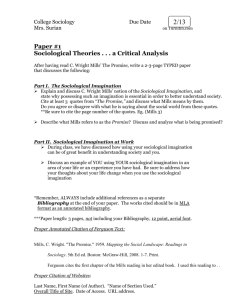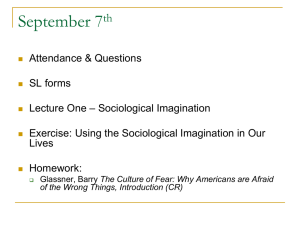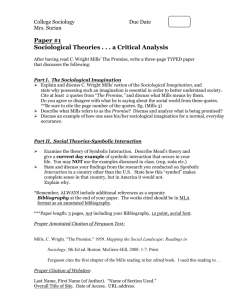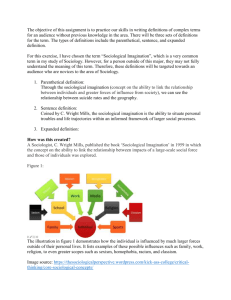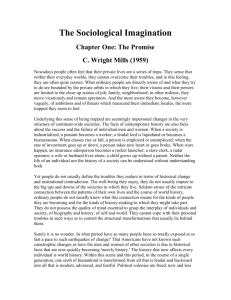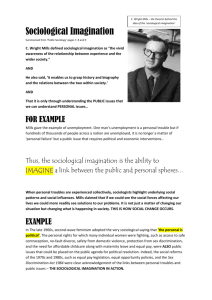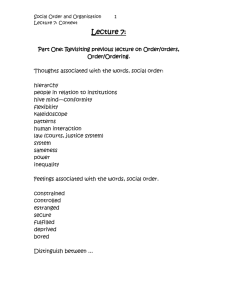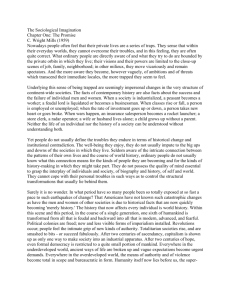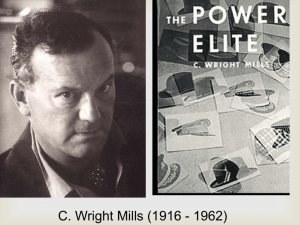Time-Line: Intersecting Biography and History Andrew Austin
advertisement
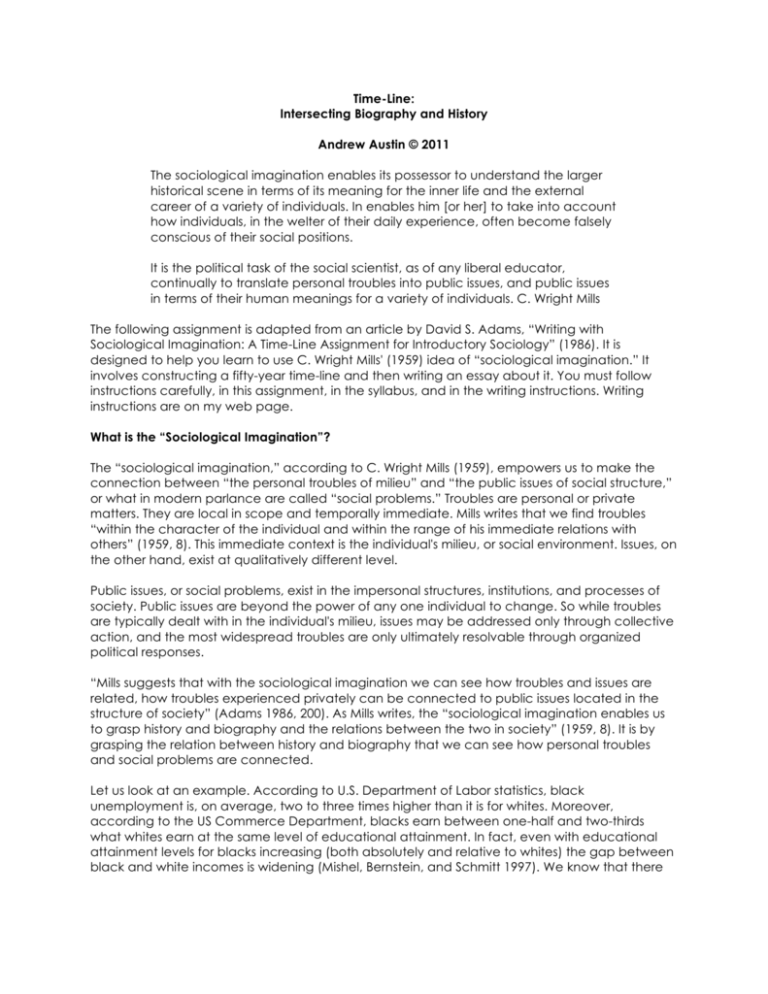
Time-Line: Intersecting Biography and History Andrew Austin © 2011 The sociological imagination enables its possessor to understand the larger historical scene in terms of its meaning for the inner life and the external career of a variety of individuals. In enables him [or her] to take into account how individuals, in the welter of their daily experience, often become falsely conscious of their social positions. It is the political task of the social scientist, as of any liberal educator, continually to translate personal troubles into public issues, and public issues in terms of their human meanings for a variety of individuals. C. Wright Mills The following assignment is adapted from an article by David S. Adams, “Writing with Sociological Imagination: A Time-Line Assignment for Introductory Sociology” (1986). It is designed to help you learn to use C. Wright Mills' (1959) idea of “sociological imagination.” It involves constructing a fifty-year time-line and then writing an essay about it. You must follow instructions carefully, in this assignment, in the syllabus, and in the writing instructions. Writing instructions are on my web page. What is the “Sociological Imagination”? The “sociological imagination,” according to C. Wright Mills (1959), empowers us to make the connection between “the personal troubles of milieu” and “the public issues of social structure,” or what in modern parlance are called “social problems.” Troubles are personal or private matters. They are local in scope and temporally immediate. Mills writes that we find troubles “within the character of the individual and within the range of his immediate relations with others” (1959, 8). This immediate context is the individual's milieu, or social environment. Issues, on the other hand, exist at qualitatively different level. Public issues, or social problems, exist in the impersonal structures, institutions, and processes of society. Public issues are beyond the power of any one individual to change. So while troubles are typically dealt with in the individual's milieu, issues may be addressed only through collective action, and the most widespread troubles are only ultimately resolvable through organized political responses. “Mills suggests that with the sociological imagination we can see how troubles and issues are related, how troubles experienced privately can be connected to public issues located in the structure of society” (Adams 1986, 200). As Mills writes, the “sociological imagination enables us to grasp history and biography and the relations between the two in society” (1959, 8). It is by grasping the relation between history and biography that we can see how personal troubles and social problems are connected. Let us look at an example. According to U.S. Department of Labor statistics, black unemployment is, on average, two to three times higher than it is for whites. Moreover, according to the US Commerce Department, blacks earn between one-half and two-thirds what whites earn at the same level of educational attainment. In fact, even with educational attainment levels for blacks increasing (both absolutely and relative to whites) the gap between black and white incomes is widening (Mishel, Bernstein, and Schmitt 1997). We know that there 2 are no significant racial differences that explain these inequalities, since race is not a biological reality. So what is causing employment and income inequality between blacks and whites? When we examine black unemployment and income in the context of a racialized social structure and a history of slavery, segregation, discrimination in housing, and the split labor market, we can see that these structural problems and the personal troubles that stem from them are caused by the social problem of racism – racism not narrowly defined as prejudice based on skin color, but racism as a objective social force that shaped the American life. Developing this ability, that is, the “sociological imagination,” has advantages beyond simply identifying more clearly the structures that determine and limit individual lives. The sociological imagination helps us avoid “blaming the victim” (Ryan 1972). This problem occurs when people who are oppressed and disadvantaged by social forces beyond their control are held to be the cause of their situation and the suffering they experience. One blames the victim when, for instance, unemployment is attributed to a lack of motivation on the part of the unemployed person, when in fact unemployment is a macroeconomic phenomenon, determined by the structure, cycles, and imperatives of the capitalist system and state policy, all forces beyond the control of unemployed individuals – as individuals. The sociological imagination allows us to see that reality. Through the sociological imagination, we can escape the false belief that poor people are to be blamed for poverty or that minorities are to be blamed for racial discrimination. The poor and minorities are no more to be blamed for their situation or their suffering than, as Michael Parenti (1996) put it: a corpse is to be blamed for murder. Holly Sklar (1995) put it this way: impoverished women don't create poverty any more than slaves created slavery. Usually, however, and unfortunately, “men and women in mass societies are not always able to see how their private troubles and the social issues of their society are connected” (Adams 1986, 200). To the end of correcting this nearsightedness, the objective of the time-line assignment is to raise consciousness about the intrinsic connection between social problems and personal problems. It is to helps the student become more aware of the objective connections between the individual and society by asking her or him to explore these connections in her or his own life. Constructing the Time-Line The first task is to construct (carefully draw or computer-generate) a 50-year time-line. You are to start in the 1960s (1961) and end in the present (2011). If you need to go back a bit further to capture a bigger picture of your grandparents’ lives, then that’s fine; but keep the time frame to three generations including yours. You begin by drawing a line down the middle of a sheet of paper. The line can either bisect the paper horizontally or vertically. Date the line at whatever intervals you feel comfortable with (5 year or decade intervals), but it should indicate the years precisely. Above the drawn line (or on the left side of the line if you draw it vertically), you are to identify, in chronological order, significant events and trends in the history of the United States over the past 50 years. This involves political, economy, social, and cultural events, trends, and movements. I do not want a superficial event-driven chart; do not only put on your chart presidential elections or technological innovations. Examples of events, trends, and social movements in this time frame would be the end of WWII and the return to a peace-time economy, the Vietnam War, the Civil Rights movement, the increasing proportion of women in the workforce, the capitallabor accord, the Women's movement, the Vietnam War, etc. Identify social problems on this 3 part of the chart, e.g., racism, recessions, war, etc. This is the “public issues/social problems” area of your chart. Below the line (or on the right side, if the line is vertical), you are to identify, in chronological order, significant events and transitions in your life and the lives of your family, and, if important, in the lives of relatives and friends. This is the “personal troubles” area of your chart. You will start, obviously, with your grandparents' lives and then move forward in time, reconstructing the timeline of your family in the context of the time-line of world history. To perform this task, you will need to consult your parents, grandparents, and other relatives and family friends, historical family documents, secondary historical documents, such as history books (college history textbooks are a good source; I highly recommend Howard Zinn’s A People's History of the United States), detailed atlases, almanacs, and other sources that will answer your research question: How has history and social structure shaped my life? There are cases where the student is adopted or the grandparents’ or parents’ history is not otherwise known. However, there is no reason why such situations should cause students consternation; in those cases where special histories have to be produced, time-line essays are often quite fascinating. After all, we all have biographies! I understand that some students may be reluctant to discuss their own lives in this assignment, so I want to emphasize that I am the only person who reads the assignment; strict confidentiality is maintained. However, if you are still uneasy about using your own history, then you need to choose a research subject other than yourself and perform the same assignment, simply replacing yourself and your family with the research subject and that subject's family. You need to make the research subject anonymous and not disclose to anybody including me, either directly or indirectly, the identity of the research subject. Ethical behavior is crucially important when doing social research, so if you are uncertain of the ethics sociology observes in such cases, then consult the ethics guidelines of the American Sociological Association on the Internet at http://www.asanet.org. Organization of the Essay After completing your time-line and collecting your data, your next step is to organize the data into a research report, the time-line essay. The introduction to the report requires generating in your own words a discussion similar to the one presented in the introduction above. Course materials are essential for constructing your introduction, especially the on-line reading by Mills. In your summary of Mills' idea, you should also foreshadow the content of your essay with instances from investigations of your life. You will find instructions on how to properly construct an essay on my web page. The essay part is where you make all the connections between your family history and the larger history in which your family members live and work, and use sociological insight to make sense of it all in terms of public issues. The essay should demonstrate historical sensibility, that is, it should demonstrate your ability to grasp the texture of the past and present. You should be able to express your understanding of the world from the perspective of yourself and family members, at the same time you describe the objective conditions out of which those perspectives emerge. Mills writes that “in the welter of...daily experience...the framework of modern society is sought, and within that framework the psychologies of a variety of men and women are formulated” (1959, 5). In other words, for this task you are a sociologist, and it is your task to locate your 4 subjects' impressions of these historical events and their lives in both subjective and objective reality. This is historical research, and you will need to do several things, according to Neuman (1995, 382): (1) reconstruct history from fragments and incomplete evidence; (2) avoid using only your own awareness and understanding of factors outside your milieu; (3) include the role of consciousness and individual behavior in context, using their motives and actions as one level of causal factors; (4) see individual motives and actions as contingent on conditions, structures that lie beyond the consciousness of the actors (or beneath the surface of appearance), and the result of a confluence of factors or elements; and (5) compare the elements (people, events, locations) and the linkages between elements at micro and macro levels or layers of social reality, i.e., you must be able to take particular and specific events and circumstances and link these to larger social structures and historical processes. This means that you must learn to avoid abstracting the individual from her or his social location and falsely generalizing this abstraction, and instead learn to explain the individual, her or his motives, and behaviors in concrete historical settings. By way of an example, one student who did this assignment for this class was the daughter of a man trained in managing workers in the military arms industry. The arms industry is, in part, dependent on national political goals. In the late 1970s, when former naval officer Jimmy Carter, then president of the US, set in motion one of the largest peace-time expansions of US military capability in history, and when Ronald Reagan continued and stepped-up this expansion in the 1980s (to boost a flagging US economy), this student's family's fortunes changed. They moved into a bigger house, bought new cars. Their material life was dramatically improved because the state was expanding the military-industrial complex. However, after the dismantling of the Soviet state by Mikhail Gorbachev and his team of reformers, and after domestic public opinion perceived the US budget deficits as crippling the national economy, US defense spending began to be scaled back. The student's family's fortunes, which had looked up during the militarization of the 1980s, now became increasingly precarious, the main justification for military spending (the Cold War) evaporated with the Soviet Union. Her father was “downsized,” so to speak. They had to sell their home and move into a smaller one, and make other adjustments. Clearly, world political and economic events, electoral politics, economic crisis, the fall of the Soviet Union, and the end of the Cold War, affected the life of this student. She learned that her father's unemployment was not due to personal idiosyncrasies, such as laziness or incompetence; but rather he was laid-off from a career he was specifically trained for because the US government downsized the military. He had to go out and find another job, a job for which he was not adequately trained, for much less pay. His family's material and social standing was drastically changed because of political decisions and world events. Other excerpts of student essays from Adams' original essay on time-lines illustrate what I am expecting from you: During World War II, my family underwent some great changes. My grandmother took a second job, working in the woolen mills making army blankets. My grandfather joined the marines and moved his whole family from Ohio to California.... It was during this time that my grandparents divorced. Divorces are higher during any period of dramatic economic changes. Although I'm sure my grandparents blamed themselves, their divorce was a product of the economy and society. The same theory holds true for my parents. When they divorced, they blamed themselves, wondering what each had done wrong, as I did. When I look at what was 5 happening in the economy, the similarities [with my grandparents] are easy to see. The nationwide divorce rate was up dramatically and the economy was beginning to take a terrible turn for the worse. When people ask me why I enrolled in college a year ago, I usually answered that I enrolled because I wanted to. I realize now that my answer cannot be quite that simple. Because my family doctor believed that the “pill” was finally proven safe in 1963, I was able to plan my family. In doing so, my son and daughter are nearly raised and I am still young enough to pursue a second career. More than any other factor, though, the women's movement probably was the greatest influence on my decision. The successes of the movement in social equality have given me the necessary courage and confidence to attempt to be more than a mere shadow of my husband's social position. The relationship between events in society and my personal life are so tied together it's scary. My childhood was wrapped up with the effects of the Korean War and my marriage with the Vietnam War. The availability of AFDC for women and children who cannot support themselves made it possible for me to get a divorce. The women's movement let me think that I could make it alone. The recession let me know I couldn't. Reaganomics is doing its best to fail me now that I have a definite goal. Conclusion The purpose of the time-line assignment is to raise awareness about the fundamental connection between personal problems and social problems. This assignment is designed to aid students in becoming more conscious of the linkages that exist between the individual and society by asking her to examine the associations in her own life. During the course of this examination, students may find that things they were taught to blame themselves for are actually the result of systemic forces in their lives. They may be better able to understand the social forces that shaped the destinies of their parents and grandparents. Students may come to understand how social class, race, and gender locations privilege or limit their lives and the lives of their fellow human beings. At least this is the promise of the assignment. 6 Works Cited Adams, David S. 1986. “Writing with Sociological Imagination: A Time-Line Assignment for Introductory Sociology.” Teaching Sociology 14: 200-203. Mills, C. Wright 1959. The Sociological Imagination. Oxford University Press. Mishel, Lawrence, Jared Bernstein, and John Schmitt 1997. The State of Working America 19961997. Economic Policy Institute. Neuman, W. Lawrence 1991, Social Research Methods: Qualitative and Quantitative Approaches. Boston: Allyn and Bacon. Parenti, Michael 1996. Dirty Truths. New York: City Lights. Ryan, William 1972. Blaming the Victim. New York: Vintage. Sklar, Holly 1995. “Back to the Raw Deal.” Z Magazine, November: 19-24. Zinn, Howard 1995. A People's History of the United States 1492-Present (revised). New York: HarperPerennial.
